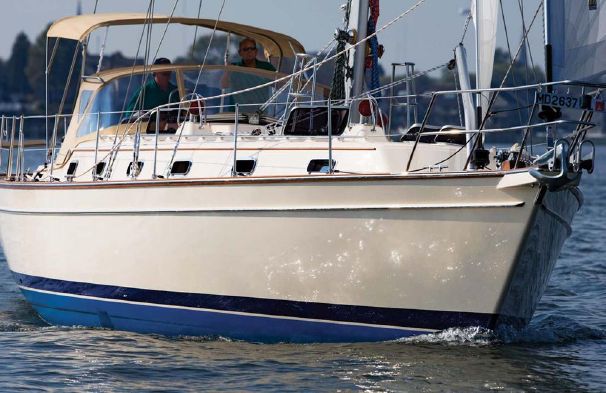I chose Flying Fish, an Island Packet 460, as the vessel to take me around the world.
Since 1979, Island Packets have logged millions of miles of cruising in all environments, from liveaboards sailing in protected coastal waters to solo circumnavigations. It is a boat designed to sail to any anchorage, weather any storm, or pursue any dream.
The inspiration comes from Naval Architect and company owner Bob Johnson, whose passion for sailing blossomed at an early age. He was only 14 years old when he lofted his first sailboat on his family’s living room floor. Then he sailed it to Lake Worth, FL with his brother holding a garden umbrella for a spinnaker.

Naval Architect and IP460 Designer Bob Johnson was only 14 years old when he lofted his first sailboat on his family’s living room floor.
As a mechanical engineer, Johnson ended up at McDonnell Douglas designing missiles but his heart was still with sailboats. With a master’s degree from MIT in naval architecture, he went to Florida and worked with Irwin Yachts, and later Endeavor, gradually becoming a general manager. He started Island Packet in 1979, borrowing money to buy the molds for a 26-footer. He wore every hat at the company — engineer, purchasing agent, production manager, and sales staff. Island Packet grew to a peak of two hundred employees in a state-of-the-art facility and has developed, over the decades, into one of the world’s most respected sailboat companies.
Bob Johnson’s style of design has been described as evolutionary. A dedicated observer, Johnson had seen boats go from full-keel, wineglass-shaped hull forms to fin-keeled hulls with U-shaped underbodies. He was struck by the fact that there had been no logical transition from one design extreme to the other. He felt that something sensible, seaworthy, and manageable was missing. He decided to utilize the best of both extremes by starting with a modern U-shaped hull for performance and adding a long keel for seaworthiness. The design not only stretched the fin keel and made it shallower, but by making it into an airfoil shape he greatly improved the keel’s hydrodynamics. Next, he focused on the rudder. Instead of a big barn door rudder hung on the aft end of the keel, Johnson separated the two and connected the bottom of the keel to the bottom of a counterbalanced spade rudder. The underbody now maintained the stability and seaworthiness of a long keel, the response of a spade rudder, and the advantage of a shallow draft. With this design, the hull also had greater protection from grounding. An internally ballasted keel had less exposure to damage compared to the relative vulnerability of keel bolts or torn-out bottoms possible on some deep fin keel, and spade rudder designs. It was revolutionary and conservative, but more importantly, it was a smart and safe design.
From the engineering to the integration of advanced proprietary materials, every aspect of the design and manufacturing process at Island Packet Yachts is built to endure. They have been described as the Land Rover of cruising sailboats. Island Packets have recorded more than 15 circumnavigations including a solo, non-stop sail around the world. And while Island Packets have now firmly established their cruising credentials by logging millions of sailing miles around the globe, they’ve also proven their performance potential by winning a showcase full of trophies in offshore races and regattas throughout the United States and Europe. Island Packet race winners include a Newport to Bermuda first in class and numerous wins in the Caribbean 1500.
In recognition, the IP460 has won Cruising World Magazine’s Boat of the Year Award.
LOA 48′ 9″
LWL 38′ 1″
Beam 14′ 4″
Draft 5′ 0″
Standard Sail Area 1,148 sq. ft.
Ballast 12,000 lb.
Displacement 32,000 lb.
Fresh Water Capacity 260 gal.
Fuel 160 gal.
Mast Height 62′ 0″
Engine 75-hp. Yanmar diesel



Hello, Jeffery.
Like so many here, I enjoy reading your posts and your vivid descriptions of the places you visit. Your writing is inspirational for someone like me who hopes to one day set off on a similar adventure.
If you were inclined to write them, I’d also be interested in a continuation of this ‘Boat & Design’ portion of your blog. In particular, I’d be interested in how your design and equipment choices have panned out. What equipment could you do without and what have you found indispensable?
I’m also interested in the practicality of layout details like the dedicated forward facing nav station of an IP 460 opposed to the side-facing layout of an IP 420. Or, why you chose an aft cockpit over a center cockpit model. I would appreciate reading about your experiences and opinions regarding the practicality of your boat’s design, maintenance, equipment, or handling.
Regards,
Dan
LikeLiked by 2 people